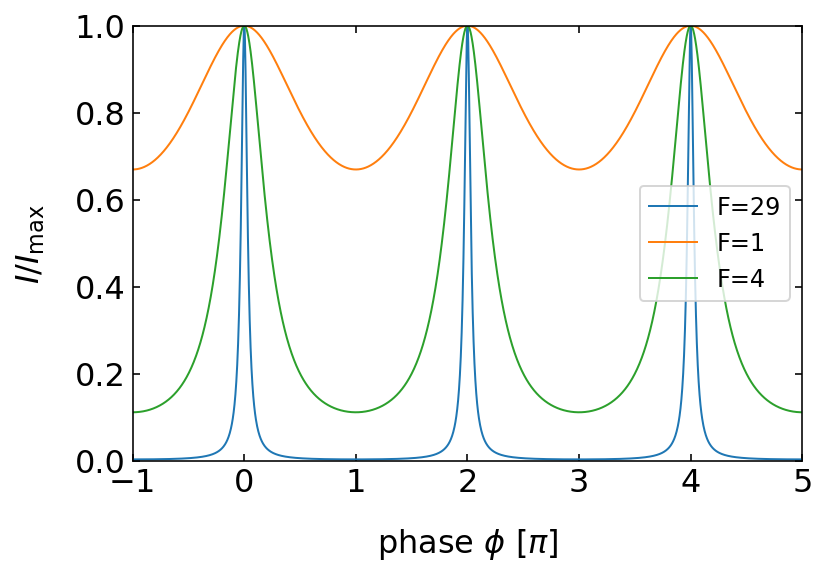This page was generated from `/home/lectures/exp3/source/notebooks/L9/MultiWave Interference.ipynb`_.
Multiple Wave Interference¶
So far we looked at the interference of two waves, which was a simplification as I mentioned already earlier. Commonly there will be a multitude of partial waves contribute to the oberved intereference. This is what we would like to have a look at now. We will do that in a quite general fashion, as the resulting formulas will appear several times again for different problems.
Nevertheless we will make a difference between
multiwave interference of waves with the same amplitude
multiwave interference of waves with decreasing amplitude
Especially the latter is often occuring, if we have multiple reflections and each reflection is only a fraction of the incident amplitude.
Multiple Wave Interference with Constant Amplitude¶
In the case of constant amplitude (for example realized by a grating, which we talk about later), the total wave amplitude is given according to the picture below by
where we sum the amplitude over
The amplitude of the p-th wave is then given by
with the index
which is a geometric sum. We can apply the sum formula for geometric sums to obtain
We now have to calculate the intensity of the total amplitude
which we can further simplify to give
|
|---|
Fig.: Multiple wave interefence. Left: Phase construction of a multiwave intereference with M equal amplitude waves. Middle: Intensity distribution obtained as a function of the phase shift |
The result is therefore an oscillating function. The numerator
where
and we have to determine the limit with the help of l’Hospitals rule. The outcome of this calculation is, that
which can be also realized when using the small angle approximation for the sine functions.
Since he numerator is much faster oscillating then the denominator, we may also encounter the situation, where the numerator is zero, but the denomintor is not. These situations result in the additional minima between the primary maxima. We will have exactly
Multiple Wave Interference with Decreasing Amplitude¶
We will turn our attention now to a slight modification of the previous multiwave interference. We will introduce a decreasing amplitude of the individual waves. The first wave shall have an amplitude
where
The intensity of the incident wave is multiplied by a factor
Intensity at Boundaries
The amplitude of the reflected wave is diminished by a factor
In the absence of absorption, reflectance
Consequently, the third wave would be now
|
|---|
Fig.: Multiple wave interefence with decreasing amplitudes. Left: Phase construction of a multiwave intereference with M equal amplitude waves. Right: Intensity distribution obtained as a function of the phase shift |
This yields again
Calculating the intensity of the waves is giving
which is also known as the Airy function. This function can be further simplified by the following abbrevations
and
where the latter is called the Finesse. With those abbrevations, we obtain
for the interference of multiple waves with decreasing amplitude.
This intensity distribution has a different shape than the one we obtained for multiple waves with the same amplitude.
|
|---|
Fig.: Multiple wave interference with decreasing amplitude. The graph shows the intensity distribution over the phase angle |
We clearly observe that with increasing Finesse the intensity maxima, which occur at multiples fo



